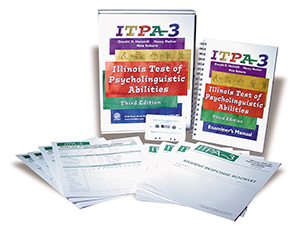NEWS & PROMOTIONS
ITPA-3-1 Complete Kit . . . . . . . . . . . . . . . . . . . . . . . . . . . . . . . . . . . . . . $251.00
Illinois Test of Psycholinguistic Abilities–Third Edition (ITPA-3)
Donald D. Hammill • Nancy Mather • Rhia Roberts
User Qualifications Required ... See Order Form Here
Ages: 5-0 through 12-11
Testing Time: 45 to 60 minutes
Administration: Individual
The ITPA-3 is an effective measure of children's spoken and written language. All of the subtests measure some aspect of language, including oral language, writing, reading, and spelling. The content in this edition is consistent with Charles Osgood's original communication model and also with the adaptations of that model made by Samuel Kirk, James McCarthy, and Winifred Kirk. Chief among the assumptions underlying this model are:
- language is an important part of a child's development,
- the essential components of language are measurable,
- these language components can be improved through instruction, and
- instruction in language is relevant to success in basic school subjects, particularly reading and writing.
PRIMARY USES OF THE ITPA-3
This test can help you:
- determine children's specific strengths and weaknesses among linguistic abilities;
- document children's development in language as a result of intervention programs;
- identify children with general linguistic delays in the development of spoken and written language;
- contribute to an accurate diagnosis of dyslexia (adequate spoken language with poor word identification and spelling skill), using the oral language/written language discrepancy score;
- clarify the aspects of language that are difficult for a particular child (e.g., phonology, syntax, semantics);
- identify specific strengths and weaknesses in language to assist with the development of appropriate instructional goals, and
- differentiate between children with poor phonological coding (ability to read and spell phonically regular pseudowords) and those with poor orthographic coding (ability to read and spell words with an irregular element). Furthermore, the Sight-Symbol processing and Sound-Symbol processing scores help identify deficits in written symbol processing, which can aid in planning appropriate strategies and accommodations.
SUBTESTS
Spoken Language
- Spoken Analogies: The examiner says a four-part analogy, of which the last part is missing. The child then tells the examiner the missing part. For example, in response to "Birds fly, fish _____," the child might say, "swim."
- Spoken Vocabulary: The examiner says a word that is actually an attribute of some noun. For example, the examiner may say, "I am thinking of something with a roof," to which the child might respond, "house."
- Morphological Closure: The examiner says an oral prompt with the last part missing. For example, the examiner says, "big, bigger, ___," and the child completes the phrase by saying the missing part, "biggest."
- Syntactic Sentences: The examiner says a sentence that is syntactically correct but semantically nonsensical (e.g., "Red flowers are smart"). The child repeats the sentence.
- Sound Deletion: The examiner asks the child to delete words, syllables, and their phonemes from spoken words. For example, the examiner might ask the student to say "weekend" without the "end."
- Rhyming Sequences: The examiner says strings of rhyming words that increase in length, and the child repeats them (e.g., "noon," "soon," "moon"). Written Language
- Sentence Sequencing: The child reads a series of sentences silently and then orders them into a sequence to form a plausible paragraph. For example, if the following three sentences were rearranged in B, C, A order they would make sense: A. I go to school. B. I get up. C. I get dressed.
- Written Vocabulary: After reading an adjective (e.g., "A broken ____"), the child responds by writing a noun that is closely associated with the stimulus word (e.g., "vase" or "mirror").
- Sight Decoding: The child pronounces a list of printed words that contain irregular parts (e.g., "would," "laugh," "height," "recipe").
- Sound Decoding: The child reads aloud phonically regular names of make-believe animal creatures (e.g., Flant, Yang).
- Sight Spelling: The examiner reads aloud irregular words one by one in a list. The child is given a printed list of these words, in which the irregular part of the words and one or more phonemes are missing. He or she writes in the omitted part of the words. For example, the examiner says, "said," the child sees s___d, and he or she writes in the missing letters, "ai."
- Sound Spelling: The examiner reads aloud phonically regular nonsense words, and the child writes the word or the missing part.










